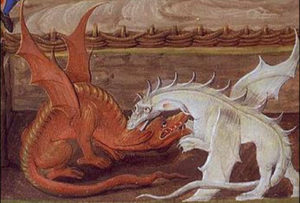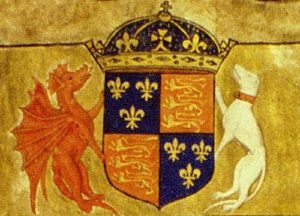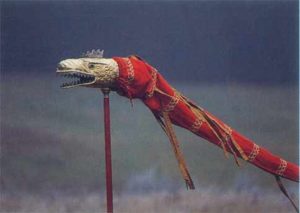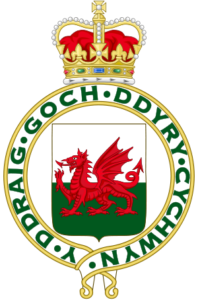Appreciate A Dragon Day
In honour of Appreciate A Dragon Day, we’ll be revealing the strange history of our very own Welsh red dragon, so pull up a pew and listen well!
How Dragons Came To Britain
Dragons have been used as symbols for thousands of years in various countries throughout the world, with different meanings ascribed in each place.
The red dragon as we know it was very likely introduced to Britain by the Romans, who in turned picked up its usage from the Sarmatians. In fact, it would be incredibly difficult to pin the dragon’s influence down to one particular peoples; regardless, it came over to Britain with the Romans.
The Romans used a dragon as their standard, which was a metal or cloth animal head with streaming cloth behind it. It was used in battle as a symbol of the Roman cohort at least in the time between 250 and 400AD.
It was adopted by the Welsh Kings of Aberffraw in the early fifth century, using it as a battle standard and bearing the origins of the name “Pendragon”.
Around the year 829, the Historia Brittonum was produced, claiming to hold the stories of Britain’s origin. Some of these stories were later elaborated on in the Mabinogion, which leads to the great story of the dragons’ battle for Britain.
The Red and White Dragons
According to the story, Llud was the king of Wales who instated his brother Llefelys as the king of France thanks to a successful marriage. However, Llud’s kingdom suffered from terrible plagues which disrupted the peace, the second of which was an horrific scream emanating from the earth each May Day which would cost women to miscarry and animals to die.
 Llud travelled to France to ask his brother for advice. Llefelys suggested that the screams came from a pair of dragons which were locked in battle together; a white dragon and a red dragon. The only way to get rid of them was to dig a huge pit in the centre of Britain, fill it with mead to get the dragons drunk and sleepy, and then wrap them in cloth to imprison them. It worked perfectly, and no longer did the country suffer from the dragons’ screams.
Llud travelled to France to ask his brother for advice. Llefelys suggested that the screams came from a pair of dragons which were locked in battle together; a white dragon and a red dragon. The only way to get rid of them was to dig a huge pit in the centre of Britain, fill it with mead to get the dragons drunk and sleepy, and then wrap them in cloth to imprison them. It worked perfectly, and no longer did the country suffer from the dragons’ screams.
This tale reappered later in the Historia Brittonum, in which King Vortigen attempts to build a castle but finds that each night the walls are being torn down. A consulting wizard advises him that the blood of a boy without a father must be spilled, but the boy they find (who is sometimes referred to as Merlin from Arthurian legend) tells them of the dragons. The king digs up the dragons who continue their epic battle, until at last the red dragon is victorious; the boy reveals that the red dragon symbolises the Britons, while the white dragon symbolises the invading Saxons.
A Royal Standard
 The next major mentions of the red dragon as a symbol for Wales come during Henry VII’s campaign against Richard III. Coming from Wales, Henry Tudor used the red dragon consistently to gain support from his Welsh brethren in the lead up to his all-important battle, and the Welsh flag as we know it – the red dragon on a field of green and white – was first used on August 22nd 1485, when Henry defeated Richard III at the battle of Bosworth Field. Owing much of his success to his Welsh lineage, Henry VII established the red dragon in the Tudor royal arms.
The next major mentions of the red dragon as a symbol for Wales come during Henry VII’s campaign against Richard III. Coming from Wales, Henry Tudor used the red dragon consistently to gain support from his Welsh brethren in the lead up to his all-important battle, and the Welsh flag as we know it – the red dragon on a field of green and white – was first used on August 22nd 1485, when Henry defeated Richard III at the battle of Bosworth Field. Owing much of his success to his Welsh lineage, Henry VII established the red dragon in the Tudor royal arms.
The Modern Flag
The red dragon on green mount was adopted as the Royal Badge of Wales as recently as 1807, and remained as such until 1953, when the motto “Y Ddraig goch ddryry cychwyn” (“The red dragon leads the way”) was appended to it. This version of the flag lasted just six years, until it was rolled back to the simply the red dragon passant over the field of green and white. It’s thought that one of the reasons for the rejection of this motto was the unintentional double entendre in the original poem from which the phrase came.
So there we go! An ancient legend, a Welsh king of Britain and a controversial slogan later, we have the Welsh flag (which, incidentally, is the only of the United Kingdom’s flags not to be incorporated into the Union Jack). Appreciate the red dragon!


